Copyright 2010
Causes and Predisposing Factors
Although tobacco and smoking have been around since antiquity, lung carcinoma was a rare disease in the early part of the 20th century. In the 19th century, cigars were in vogue, and cigarettes were confined to the poorer people and were made from the remnants of the leaves that were not used for the cigars.

Cigars are not as carcinogenic as cigarettes probably due to the fact that cigar smoke is not usually inhaled. In the early 1900’s cigar smoking was associated with elegance and currently portrays a sense of bravado as demonstrated in this image.
Courtesy Ashley Davidoff MD 13021g
TheCommonVein.net
During WWI, cigarettes were distributed freely by the companies to the soldiers, and the culture received their dividend for this “kind” deed 20-30 years later when cancer unfolded.
The medical community started to understand the dangerous relationship between cigarettes and cancer in the 1940’s but WWII and the movie industry introduced a second popular wave in the 30’s and 40’s so that the medical knowledge was not sufficiently in the public consciousness and was preempted by the movie industry. The second wave caught the fancy of the female population, as cigarettes were portrayed as the elegant and “in” thing to do, and the 60’s saw a second peak of the disease – 20-30 years later.

Collage of cigarette advertisements of the early 20th century revealing a portrayal of elegance, feminism, and manhood. The advertising campaigns worked well for the cigarette companies but had a dismal result on health. The third image from the left in the top row shows a physician who states that “Luckies are less irritating”
The world war brought free cigarettes to the soldiers from the tobacco companies. The effect on the soldiers and the culture was a devastating rise in carcinoma 20 years after the event, with peaks in the incidence of carcinoma in the 1940’s and then in the 1960’s.
54458 code historical
Ashley Davidoff MD
The CommonVein.net

80 year old male with a lung cancer and 9 cigarettes in his pocket.
There lies the evidence
Ashley Davidoff MD TheCommonVein.net
The earlier carcinomas were dominated by squamous carcinoma, but there has now been a shift to adenocarcinoma. The reason for this is not obvious but two explanations are forth coming. It is well known that adenocarcinoma is more likely to occur in females and squamous in males and since a large part of the second wave was the introduction of smoking in females an appropriate rise in adenocarcinoma occurred. It is unknown why females have a tendency to adenocarcinoma, (rather then squamous) but this seems to be well recognized. The second explanation relates to the modification and reduction of nicotine content and development of filters by the companies as a result of the evolving knowledge of the relationship to cancer. This was the compromise of the companies to take “responsible” action. Cigarette smokers reacted by deeper and longer draws on the cigarette bringing the smoke and carcinogens into contact with the alveolar epithelium and hence the evolution of the peripheral carcinoma – ie adenocarcinoma.
Statistics
Deaths
World Health Organization maintains that approximately 3,000,000 people die worldwide each year as a result of smoking. In the 20th century approximately 100 million people died from tobacco associated diseases. It is the most common type of new cancer cases at 1.2 million new cases, or 12.3% of new cancers cases in the world (Huq). Overall, lung cancer is the most frequent fatal malignancy and accounts for more than 7% of all deaths in both sexes.
The annual number of deaths from lung cancer in the United States increased from 18,000 in 1950 to an estimated 158,000 in 1997 and 162,000 in 2008 (American Cancer Society.
In the USA lung cancer is the leading cause of cancer deaths in both men and women.
171,600 new cases of lung cancer account for 31% of cancer deaths in men and 25% cancer deaths in women, resulting in a total of 158,900 deaths. In other areas of the world, it is the leading cause in men and the second or third cause in women.
In 2000, cigarette smoking was responsible for more than 1 of every 6 deaths in the United States.
Cigarette Smoking
95% cases of lung cancer are directly related to cigarette smoking. Patients who have asbestosis and are smokers have a 90 X increase risk to develop lung carcinoma.
Number Of Cigarettes Per Day And Risk
One pack of cigarettes per day increases the risk of developing lung cancer by 20-25 fold
Two packs a day for 20 years increases the risk of developing lung cancer by 60-70 fold when compared to a non smoker
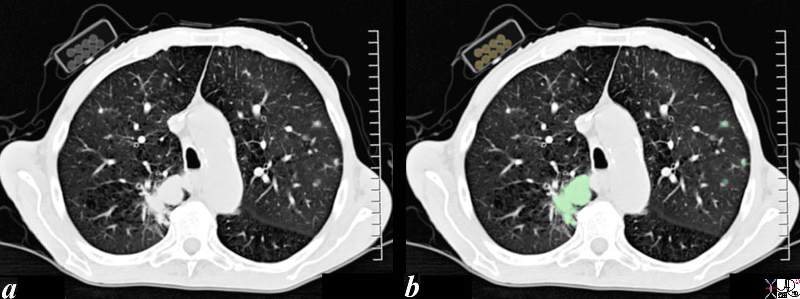
The CT scan through the chest of an 80 year old male shows a large lung mass in the posterior aspect of the right upper lobe (overlaid in green) and3 small nodules in the left upper lobe (overlaid in green). The patient is obviously a smoker and the incriminating pack of cigarettes is identified in his right shirt pocket containing 9 cigarettes. The lung cancer was shown to be an adenocarcinoma The pathology of the nodules may either represent metastatic disease or multicentric foci of bronchioloalveolar cell carcinoma. Associated finding of a thinned anterior junction line suggests hyperinflation and emphysema, and the thickened bronchial walls noted in the right lung suggest chronic bronchitis. Saber shaped trachea is also reminiscent of emphysema. The patient is emaciated, a finding that relates both to his chronic lung disease and his cancer.
Ashley Davidoff MD 87831c01b.8s
TheCommonVein.net
Age (in the USA)
Adults – approximately 45million smoke cigarettes
Teenagers approximately 2.4 million smoke cigarettes
High school seniors – 38% smoke.
Changing Cigarette Habits
Cigarette consumption dropped 37% from 1973 to 1992
Active vs. Passive Vs Non smokers
The relative risk of developing lung cancer when active vs passive long term vs. non smoker is calculated is 13:1.5:1
Passive Smoke And Cancer
In the USA, Environmental Protection Agency maintains that passive smoking accounts for about 3,000 deaths from lung cancer. The risk of dying of lung cancer is 30% higher for a nonsmoker living with a smoker compared to a non smoking home environment.
Changing Risks
It takes about 10 years for a previous smoker to reach a non smokers risk levels.
Cessation of smoking for 10 years reduces risk to control levels.
Time Lost By Smokers
Smokers lose an average of 15 years of life.
Behavioral Modification
Only 6% of smokers are successful in permanent cessation. 70 to 80% who do stop smoking return to the habit.
Sex
USA
The prevalence for males is 28% and 25% for females.
Changing Histological Patterns
Non Small Cell Lung Carcinoma (NSCLC) almost 80% of cases
Small Cell Lung Carcinoma (SCLC) 20% of cases
There are two common histological patterns of NSCLC;
adenocarcinoma
squamous cell carcinoma
Adenocarcinoma (a NSCLC) is the most common type of lung cancer, and makes up 30-35% of all cases. Adenocarcinoma has replaced squamous cell carcinoma as the most frequent histological subtype.
Squamous cell carcinoma (also a NSCLC) is the second most common type, making up about 30% of all lung cancers.
Large-cell cancer makes up 10% of all cases.
Extent of Disease at Clinical Presentation
15% of patients have only localized disease at diagnosis;
25% have disease spread to regional lymph nodes,
and >55% have distant metastases.
Extent of Disease at Autopsy
At autopsy extra thoracic metastatic disease is found >95% in patients with small cell cancer, in 80% of patients with adenocarcinoma and large cell carcinoma and >50% in patients with squamous cell (>50%).
Treatment
At presentation, approximately one-third of patients are stage I,II,or IIa meaning they have disease localized enough for a curative attempt with surgery or radiotherapy A further 30% have IIIA or IIIB with local or regional disease that has equivocal curative capability and the last 30% are stage IV meaning they have distant metastatic disease and are incurable.
Prognosis
86% of patients with lung cancer die within 5 years of diagnosis.
Only about 14% of people who develop lung cancer survive for 5 years.
Geographical Distribution
Lung cancer is most prevalent in industrialized regions of the world. The incidence is highest in Eastern Asia, in countries like China. European countries have the second highest number of new cases of lung cancer. The United States and Canada account for just under a fifth of the cases of lung cancer worldwide.
In 2001, there were about 1,238,861 new cases of lung cancer in the world
(Percentages indicate the percent of worldwide cases occurring in that region):
| Region |
Absolute Number |
% |
|
Eastern Asia: |
415844 |
34 |
|
Northern America: |
205608 |
17 |
|
Eastern Europe: |
151073 |
12 |
|
Western Europe: |
93533 |
8 |
|
Southern Europe: |
78745 |
6 |
|
South-Eastern Asia: |
60122 |
5 |
|
Northern Europe: |
52039 |
4 |
|
Southern America: |
44149 |
4 |
|
Western Asia: |
22654 |
2 |
|
Central America: |
13373 |
1 |
|
Australia/New Zealand: |
9838 |
.8 |
|
Northern Africa: |
9539 |
.8 |
|
Carribean: |
6630 |
.5 |
|
Southern Africa: |
4045 |
.3 |
|
Eastern Africa: |
2995 |
.2 |
|
Middle Africa: |
1509 |
.1 |
|
Western Africa: |
1388 |
.1 |
|
Melanesia: |
137 |
.01 |
|
Micronesia: |
103 |
.008 |
From the International Agency for Research on Cancer.
Socioeconomics
The statistics suggest an almost equal incidence of lung cancer among the socioeconomic groups.
In 2001, there were about 1,238,861 new cases of lung cancer in the world.
There were about 646,228 cases in more developed countries, accounting for 52% of the total world cases.
There were about 592,636 cases in less developed countries, accounting for 48% of the total world cases.
These numbers suggest that there is no strong predilection in the socioeconomic scale.
From the International Agency for Research on Cancer.
Population groups

This is a collage of people in London, Johannesburg, New York and Boston. Did you notice the similarity of the poodle and the blonde lady?
Ashley Davidoff
TheCommonVein.net
10369c
Genetics
There is no strong pattern of Mendelian inheritance. However in patients who have inherited disorders, such as in adult retinoblastoma (inherited mutation is rb) and Li-Fraumeni syndrome (p53 gene) there is an increased incidence in lung cancer. First degree relatives of patients with lung carcinoma have a predisposition to develop all types of carcinoma, and so patients with lung carcinoma should be educated, so that their families can become aware of this fact.
There has been an association between the p450 enzyme and lung cancer.
Within the lung cancer cell, many genetic aberrations have been identified including
mutations on the TP53, RB1, CDKN2A, and FHIT genes. Abnormal activation of dominant oncogenes and inactivation of tumor suppressor or recessive oncogenes is a well known activity among lung cancer cells. In addition, many lung cancer cells express the enzyme telomarase. Mutations in ras genes in non-small cell lung cancer are associated with a poor prognosis , and in small cell lung cancer, tumor amplification of c-myc is also associated with a poor prognosis . Molecular changes of allele loss is noted in preneoplastic lesions and possibly prior to histological changes. There is thus potential for both the early diagnosis of lung carcinoma, as well as the potential to follow effectiveness of therapy using genetic evaluation.

A large family wedding with 12 children. Note the complexion of the groom is completely different to bride’s and her family. Genetics goes deeper than we know, and the good and the bad surface intermittently. However there is no telling when this will occur or become phenotypic.
Ashley Davidoff
TheCommonVein.net
68494
Sex Predisposition
In 2001, there were about 1,238,861 new cases of lung cancer in the world.
There were 337,115 cases in females, and there were 901,746 cases in males, a ratio of 1:2.7.
Lung cancer accounts for 31% of all cancer deaths in men and 25% in women in the USA
When the non smoking cancer population is considered, women appear to have a ~1.5 fold higher susceptibility to lung cancer than men.
Eastern Africa: F: 1,284, M: 1,711 (1:1.3), T: 2,995
Middle Africa: F: 220, M: 1,289 (1:5.7) T: 1,509
Northern Africa: F: 1,658, M: 7,881 (1:4.9) T: 9,539
Southern Africa: F: 1,184, M: 2,861 (1:2.4), T: 4,045
Western Africa: F: 231, M: 1,157 (1:4.9), T: 1,388
Carribean: F: 1,832, M: 4,798 (1:2.6), T: 6,630
Central America: F: 4,047, M: 9,326 (1:2.3), T: 13,373
Southern America: F: 12,656, M: 31,493 (1:2.4), T: 44,149
Northern America: F: 85,944, M: 119,664(1:1.4), T: 205,608
Eastern Asia: F: 122,452, M: 293,392 (1:2.4), T: 415,844
South-Eastern Asia: F: 12,666, M: 47,456 (1:3.8), T: 60,122
Western Asia: F: 3,270, M: 19,384 (1:6.1), T: 22,654
Eastern Europe: F: 24,420, M: 126,653 (1:5.3), T: 151,073
Northern Europe: F: 18,063, M: 33,976 (1:1.86), T: 52,039
Southern Europe: F: 11,227, M: 67,518 (1:6.1), T: 78,745
Western Europe: F: 18,183, M: 75,350 (1:4.3), T: 93,533
Australia/New Zealand: F: 3,231, M: 6,607(1:2), T: 9,838
Melanesia: F: 54, M: 83 (1:1.6), T: 137
Micronesia: F: 28, M: 75(1:2.7), T: 103
Polynesia: F: 30, M: 79 (1:2.6), T: 109
(From the International Agency for Research on Cancer.)
Age Predisposition
Peaks between ages 55 and 65 years.
2% of all cases appear before the age of 40.
In 1996-2000, per 100,000 people in the US:
1-19: Close to 0
20-24: 0.3
25-29: 0.5
30-34: 1.4
35-39: 4.7
40-44: 12.0
45-49: 26.8
50-54: 58.5
55-59: 119.8
60-64: 207.1
65-59: 304.2
70-74: 386.9
75-79: 403.0
80-84: 382.7
86+: 264.2
(NCI SEER)
Dietary Factors
Beneficial Foods
Fruits and vegetables contain nutrients called phytochemicals which have reported beneficial effects. Phytochemicals in vegetables include: Isothiocyanates, found in broccoli, cauliflower, and brussels sprouts; Flavonoids, found in apples, grapefruit, onions, red wine, and tea; Soy protein; and Lycopene, found in tomatoes.
Vitamin C, selenium, cod liver oil, folic acid, vitamin B12, Vitamin E, and Vitamin A may also decrease the risk of getting lung cancer.
Detrimental Foods
Fat and alcohol may increase the risk.

A collage of food from the farming to the picking packaging and the eating – Who knows what is finally in the final multifaceted complex product that has so much effect on our health – “We are what we eat!”
Ashley Davidoff
TheCommonVein.net
10376c
Predisposing and Associated Diseases
Predisposing factors include smoking; exposure to secondhand smoke, radon, asbestos, arsenic, and pollution; other respiratory diseases; having lung cancer previously.
The strongest risk factors for lung cancer are tobacco exposure, previous history of lung or head and neck cancer and family history of lung cancer.
Diseases associated with smoking and lung cancer include emphysema, chronic bronchitis, and chronic obstructive pulmonary disease (COPD). Patients with these disorders should be closely monitored for carcinoma. This is a large and very important group in whom selective screening techniques should be applied. A patient with COPD who is a non smoker has a 5 fold increased risk of lung cancer.
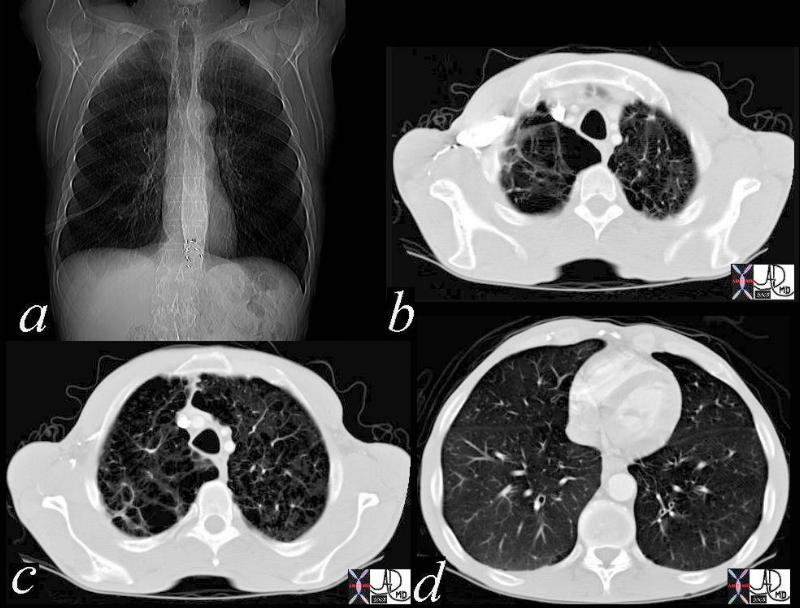
The flattened diaphragms in a are a clue to the hyperinflated lungs, confirmed by the architectural distortion, loss of structural integrity, and large bullous spaces particularly in the right upper lobe.(b,c,) The cachexia characterized by loss of the subcutaneous fat and muscle is also characteristic of the disease(d).
Ashley Davidoff MD 41860c Copyright 2010 TheCommonVein.net

Image on the left shows normal size and appearance of terminal bronchioles and alveoli. On the right the image shows the effects on the respiratory bronchioles and when severe, on the alveoli as well. Note the dilatation of the respiratory bronchiole, (rb) with some sparing of the distal part of the acinus.
Ashley Davidoff MD
TheCommonVein.net
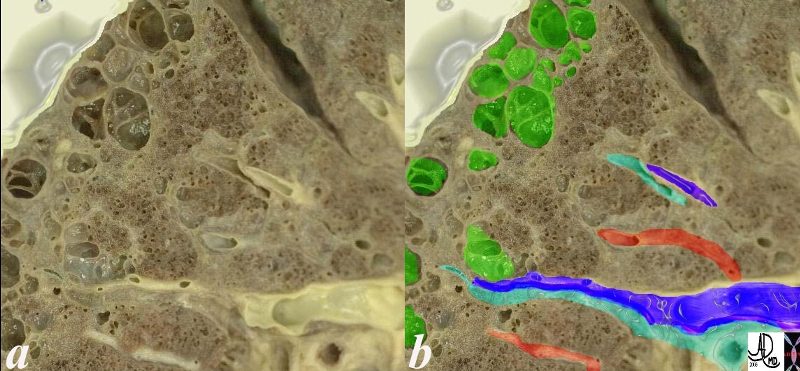
This is an image of an emphysematous lung. Note the larger air spaces where the septae between the alveoli, alveolar sac alveolar ducts and respiratory bronchioles have been broken down (green).
The bronchovascular bundle consisting of the arteriole (navy blue) and bronchiole (teal) subtends the secondary lobule. The pulmonary venule (red) originates from interlobular septa where it is intimately related to the lymphatics.
19932e
Other chronic lung diseases such as tuberculosis (TB) and chronic interstitial disease of scleroderma are at increased risk. These cancers usually arise in scars and are called scar carcinomas. When a calcification becomes eccentrically placed, it is a clue to the malignant transformation of the lesion.
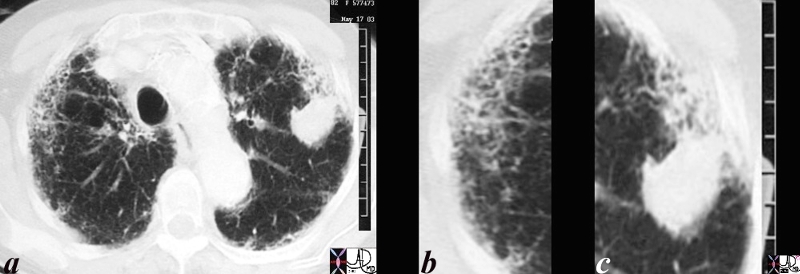 The CT is from an 82 year old male with interstitial lung disease who developed a peripheral lung cancer within the reticular disease in the periphery of the lung. The interstitial disease is highlighted and magnified in image b and the mass among the interstitial disease in the left upper lung is shown in c. In this instance, the pathology showed squamous cell carcinoma, which is the type usually associated with chronic irritation. Courtesy Ashley Davidoff copyright 2010 32181c02.8s |
Asbestos
Asbestos exposure increases the risk of lung cancer by 5 times. A combination of asbestos exposure and cigarette smoking compounds the risk by as much as 50 times, and if the patient has asbestosis and is a smoker the risk almost doubles to 90X increase. Lung cancer among asbestos workers is more common than mesothelioma. These patients also develop gastrointestinal cancers.

Ashley Davidoff MD
TheCommonVein.net.
32697
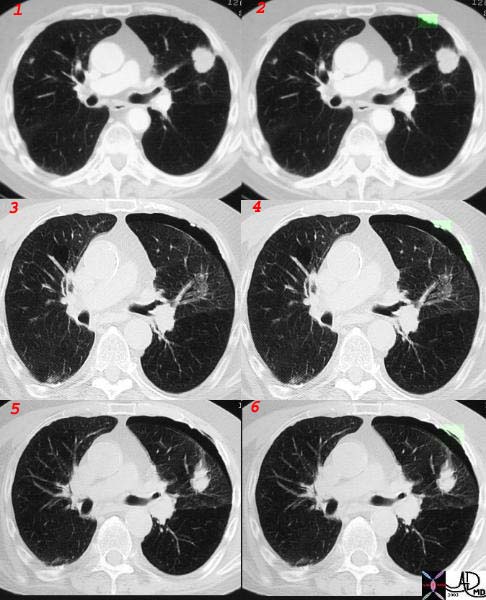
The CT through a mass in the LUL shows focal pleural calcification overlaid in green (2,4,) in this patient with asbestos related disease. A pneumothorax followed the biopsy revealing that the pleural plaques are positioned on the parietal pleura.(3,4) A small amount of air introduced from the xylocaine injection outlines the parietal pleura.(5,6 – green)
Ashley Davidoff
TheCommonVein.net
32017c.jpg
Radon Uranium Nickel and Other Metals
Lung cancer in non smoking uranium miners occur 4 times more frequently than in the general population, and occurs even more frequently among miners who smoke.
People who work with nickel, chromates, coal, mustard gas, arsenic, beryllium, and iron are more susceptible to develop lung cancer. Radon is ubiquitous and miners may be exposed to particularly high concentrations. A higher incidence of lung cancer in gold miners ha also been noted.
Environment
In the environment, pollution, radon, and radiation are predisposing elements to the development of lung cancer. An increased incidence of lung cancer among survivors of the Hiroshima and Nagasaki atomic bomb was noted.
Jagsiekte in South African Sheep
There is a disease in South African sheep called “jagziekte” which histologically is similar to bronchioalveolar cancer. Efforts to use this knowledge to identify a transmissible agent have not been successful, but it is important to continue pursuit since there a transmissible agent seems very likely.
Etiological Agent – Cigarettes
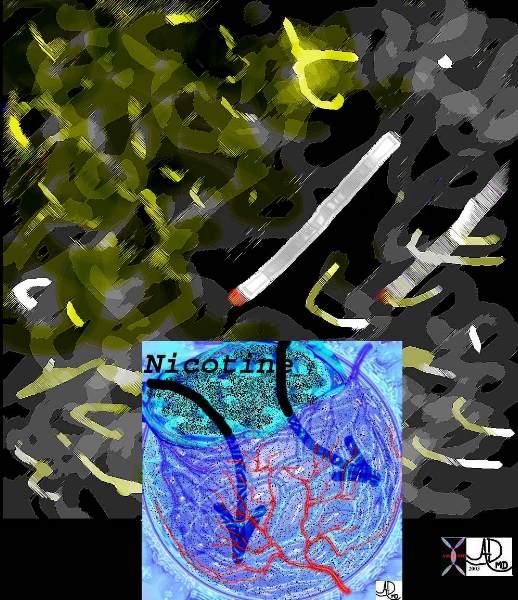
These diseases are all about cigarettes and the garbage that they deposit in our lungs.
Courtesy Ashley Davidoff MD. 32646d Copyright 2010
The CommonVein.net
John Hill a London physician first recognized an environmental cause from the dangers of tobacco use in 1761 and published a book “Cautions Against the Immoderate Use of Snuff”.
The carcinogenic effects of tobacco are due to the polycyclic aromatic hydrocarbons, which are found in the tars produced by combustion of tobacco. However there are innumerable (more than 1200) potentially carcinogenic substances in cigarette smoke as well. None of these have been shown to produce classical carcinoma in animals in the lab, but some have produced alveolar cell carcinoma – a carcinoma that bears the least causal relationship to smoking. Nicotine also contains carcinogens. It forms nitrosamines such as 4-(N-methyl-N-nitrosamino)-1-(3-pyridyl)-1-butanone (NNK) which is a carcinogen identified in tobacco smoke by Hoffmann and Hecht.
Cigarette smoking has the highest causative link with carcinoma of the lung. Cancer risks for cigar and pipe smokers are significant, but less than those for cigarette smokers.
Factors of Smoking Habit That Increase Risk
Factors that increase the risk of developing cancer in smokers include the number if cigarettes/ day, the length of the habit, and the depth of inhalation.
Number Of Cigarettes Per Day And Risk
One pack of cigarettes per day increases the risk of developing lung cancer by 20-25 fold
Two packs a day for 20 years increases the risk of developing lung cancer by 60-70 fold when compared to a non smoker
Change Of Cigarette Design
In the US, cigarettes now have a lower tar content are almost all filtered, which has resulted in a decrease in the amount of polycyclic aromatic hydrocarbons (PAHs), and appears to be lowering the risk of lung cancer.
However there has also been an increase in the amount of carcinogenic tobacco-specific n=”nitrosamines” (TSNAs) which have been shown to induce adenocarcinoma in lab animals.
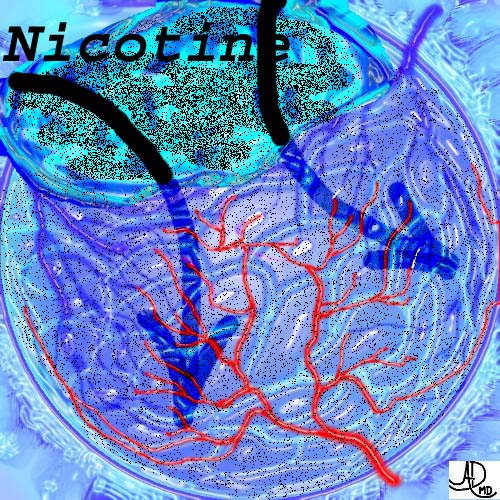
An alveolus subjected day and night for 20 years to black smog from a human chimney. It had no choice but to react.
Courtesy Ashley Davidoff MD. 32166f
The CommonVein.net

Polycyclic Aromatic Hydrocarbons (PAH’s) are by products of nicotine and are flat compounds that are similar to benzene in structure. Liver enzymes oxidize the PAH’s making their incorporation into DNA possible. The change in DNA structure leads to interference in function and a predisposition to carcinogenesis.
Image modified by Ashley Davidoff MD. 54460 The CommonVein.net
In 1996-2000, per 100,000 people in the US:
White: 63.2
Black: 81.2
Asian/Pacific Islander: 43.2
American Indian/Alaskan native: 33.1
Hispanic: 33.2
